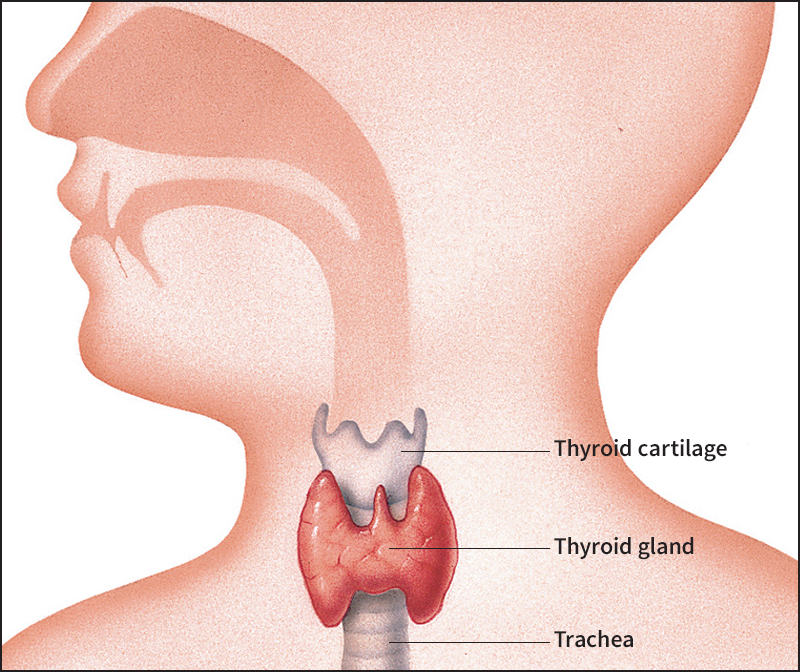Thyroid gland is an important organ in the front of the neck, below the larynx (voice box). It has two lobes, one on each side of the trachea (windpipe), connected in the center by a band of tissue called the thyroid isthmus. A network of blood vessels surrounds the gland. The gland produces thyroid hormone, which is important in many bodily functions. Disorders of the thyroid are usually treated by an endocrinologist, a physician who specializes in disorders of glands.

The thyroid takes iodine from the blood to produce thyroid hormone, which occurs in two forms—thyroxine (T4), also called tetraiodothyronine, and triiodothyronine (T3). The thyroid gland produces all of the T4 that is released into the bloodstream, but only about 20 percent of the T3 the body uses is produced in the gland. The majority of T3 in the body is produced from T4 that is converted to T3 in the muscles and in such organs as the liver and kidneys. Some T4 is stored inside the lobes of the thyroid gland in small chambers called follicles for later use.
Thyroid hormone controls the body’s cell metabolism. When thyroid hormone is released into the bloodstream, cells increase the rate at which they convert oxygen and nutrients into energy and heat for the body’s use. During a child’s development, thyroid hormone stimulates an increase in growth rate. Release of thyroid hormone also stimulates mental activity and increases the activity of other hormone-producing glands.
Thyroxine and triiodothyronine are released into the bloodstream in response to such conditions as stress, pregnancy, and low levels of thyroid hormone in the blood. Thyroid hormone levels in the body are maintained by the brain through a finely controlled feedback mechanism. If the level of any hormone is too low, the brain signals certain glands to release hormones. If the level is too high, another set of signals stops hormone release. In response to low levels of thyroid hormone, the hypothalamus, a small gland in the brain, releases thyrotopin releasing hormone (TRH). This hormone signals the pituitary gland, another small gland in brain, to produce thyroid-stimulating hormone (TSH). TSH then stimulates the thyroid gland to produce and release thyroid hormone.
The thyroid gland produces another hormone, calcitonin, in response to high levels of calcium in the blood. Calcitonin causes the kidneys to discharge more calcium into the urine, and it raises the amount of calcium stored in the bones.
Underactive thyroid,
called hypothyroidism, is a defect that results in the low production of thyroid hormones. This deficiency causes an overall decrease in both physical and mental activity. Symptoms appear in almost every organ system of the body. The skin becomes dry and puffy. Hair thins and becomes brittle. Slow speech, slow reflexes, poor memory, constipation, and fatigue can all result from hypothyroidism. In adults, hypothyroidism is called myxedema. If the condition goes untreated in infants, it causes physical and mental disability (see Congenital hypothyroidism). When hypothyroidism is detected in a newborn child, thyroid hormone supplements are given to prevent brain damage. Myxedema in an adult can also be treated with thyroid hormone pills.
Overactive thyroid,
called hyperthyroidism, results in an overproduction of thyroid hormone. Excess thyroid hormone in the blood cause an increase in the rate of most biological reactions. Symptoms of hyperthyroidism may include excessive nervousness; insomnia; sweating; diarrhea; and, in women, changes in menstruation. In a condition called Graves’ disease, hyperthyroidism can be accompanied by eye problems.
Treatment of hyperthyroidism may involve surgery to remove all or a portion of the thyroid gland. Drugs can also be used to lower thyroid hormone production. In some cases, a solution of radioactive iodine may be administered to destroy the gland. Physicians can prescribe thyroid hormone supplements to maintain proper levels of thyroid hormone in patients who have had the gland removed.
Lumps in the thyroid, called nodules, can form from normal thyroid tissue, fluid-filled cysts, inflammation of the thyroid (thyroiditis), or a tumor. Thyroid nodules occur among women more often than men. Specialized tests, such as ultrasound or a needle biopsy (removal and examination of tissue), are sometimes necessary to determine if thyroid nodules are benign (noncancerous) or cancerous.
See also Gland; Goiter; Graves’ disease; Hormone; Thyroid cancer.
